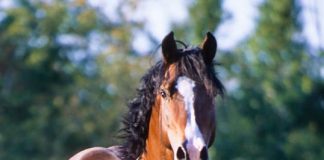There are three main enemies of growing good pastures: weather, overstocking and failure to rest the land. While weather will always be out of your control, you can do something about the other two with a little know-how.

1. Weather:
2. Overstocking:
Pastures are also stressed by horse property owners’ propensity to acquire more horses than their land can support.
“There is no way to grow and maintain quality pasture if you allow too many horses free access to an area too small for their grazing requirements,” says Jim Church, Idaho county extension office educator and co-author of Pasture Principles for Smaller Acreages. “You will always end up with a dry lot.”
|
No matter how much time, money and effort you put into improving your pastures, Church maintains it is a losing battle unless the number of horses is reduced to a ratio that the acreage can support. In areas of the country where pasture grows well, two to three acres per animal is a safe rule of thumb.
“That said, many owners on small acreages who know they have too many horses for a viable pasture successfully provide the daily nutritional requirements of their horses with good quality hay and grain,” says Church. “The pasture they have is mainly for turnout.”
3. Not Resting:
Even with an adequate horse-to-acreage ratio, pastures still need time to rest, whether they are newly established or long-existing.
“If you are establishing new pasture, seedlings need time to establish,” says Jonathan Black of the North Carolina State University extension office. “Likewise, mature, grazed pastures need time to re-grow. If in doubt, growers can follow a time-honored rule of thumb: Graze half, leave half.”
This can be amazingly difficult when your horses are pawing at the gate, leaning on your fence, and gazing longingly at the grass on the other side. Tougher yet is when hay prices soar and you are feeding bale after bale while a veritable sea of green is growing just beyond the fence. Be strong; your pasture will grow better for it.
In a country vast enough to have hurricanes on one end and mammoth snowfalls on the other, any pasture management program will need to be tailored for the location. Every region presents its own climate and soil challenges for the horse owner trying to start or maintain a healthy pasture. With a little diligent research and work, you can maintain your pastures at their absolute best for grazing.
Liked this article? Here are others on pasture management:
8 Ways to Improve Your Pasture
Pasture Maintenance
LOUANN CHAUDIER and her husband recently sold their Restless Spirit Farm and now reside with their cats and dog on three acres in a state forest.
This article originally appeared in the March 2014 issue of Horse Illustrated magazine. Click here to subscribe!






Yep
We divide our four acres into four small pastures, and rotate our 4 horses together into each pasture for a week, then to the next. I find that this keeps the pastures healthy longer into the late summer, and also gets the horses to eat some of the taller grasses that are not so tasty. Because my horses are all in the 20’s – 30’s, I do always feed a complete feed as well.